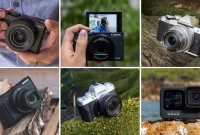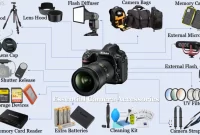With the continuous advancement of technology, smartphones have become more capable of capturing high-quality images. However, how do they compare to traditional cameras in terms of image quality? In this article, we will delve into the debate of Smartphone vs Traditional Cameras and analyze the pros and cons of each.
Advantages of Smartphone Cameras
Smartphone cameras have become increasingly popular and have revolutionized the way we capture moments. In this article, we will explore the advantages of smartphone cameras compared to traditional cameras, specifically focusing on image quality.
1. Portability
One of the major advantages of smartphone cameras is their portability. Unlike traditional cameras, smartphones are compact and lightweight, allowing us to easily carry them wherever we go. This convenience ensures that we never miss capturing special moments.
2. Ease of Use
Smartphone cameras are extremely user-friendly and require minimal technical expertise. With their intuitive interfaces and accessibility, anyone can quickly learn to operate a smartphone camera. This accessibility makes them suitable for both amateurs and professionals alike.
3. Connectivity
Smartphones offer seamless connectivity, allowing us to instantly share our photos with others through various social media platforms. This connectivity enables us to engage with a wider audience and receive immediate feedback and appreciation for our photography.
4. Editing Capabilities
Most smartphones come equipped with built-in photo editing features, enabling us to enhance our images with just a few taps. These editing capabilities eliminate the need for additional software or editing devices, making smartphone cameras a convenient all-in-one solution.
5. Constant Improvement
Smartphone camera technology is constantly advancing. With each new model, manufacturers strive to provide better image quality, resolution, and functionality. This continuous improvement ensures that smartphone cameras are always at the forefront of innovation.
While traditional cameras have their own merits, smartphone cameras offer numerous advantages, particularly in terms of portability, ease of use, connectivity, editing capabilities, and constant improvement. As technology continues to evolve, it will be fascinating to witness how smartphone cameras further enhance our photography experiences.
Limitations of Smartphone Cameras
As smartphones continue to evolve and improve their camera capabilities, it is important to understand the limitations of smartphone cameras when comparing them to traditional cameras, particularly in terms of image quality.
1. Sensor Size: Smartphone cameras generally have smaller sensors compared to traditional cameras. This affects the amount of light that can be captured, resulting in lower image quality, especially in low-light conditions.
2. Optics: The lenses used in smartphone cameras are significantly smaller and have limited focal lengths compared to traditional camera lenses. This can result in reduced sharpness, distortion, and limited zoom capabilities.
3. Manual Control: Traditional cameras offer more options for manual control, allowing photographers to adjust settings like aperture, ISO, and shutter speed. Smartphone cameras, on the other hand, offer limited manual control options, making it harder to achieve specific effects or overcome challenging lighting conditions.
4. Image Processing: Smartphone cameras heavily rely on image processing algorithms to enhance the captured images. While this can result in visually appealing photos, it can also lead to loss of details and natural-looking textures.
5. Professional Features: Traditional cameras often come with features specifically designed for professional photographers, such as interchangeable lenses and advanced image stabilization systems. Smartphone cameras, despite their advancements, cannot fully replicate these professional features.
6. Limitations in Printing: Due to their smaller sensors and limited image quality, enlarging and printing smartphone photographs, particularly for large scale prints, may result in reduced clarity and overall image quality.
Advantages of Traditional Cameras
When it comes to image quality, traditional cameras still have a lot to offer compared to smartphones. Here are some advantages of traditional cameras:
-
Superior Sensor Size
Traditional cameras typically have larger sensors compared to smartphone cameras. This allows them to capture more light and produce higher-quality images with better detail and low light performance.
-
Optical Zoom
Unlike smartphones, traditional cameras often come with optical zoom capabilities. This means you can zoom in on a subject without sacrificing image quality. With digital zoom on smartphones, the image quality tends to degrade when zooming in.
-
Manual Controls
Traditional cameras offer greater control over settings such as aperture, shutter speed, and ISO. This allows photographers to have more creative freedom and achieve the desired effect in their photos.
-
Wide Range of Lenses
Traditional cameras have interchangeable lenses, providing photographers with a wide range of options to suit different shooting scenarios. From wide-angle to telephoto lenses, photographers can capture a variety of perspectives and achieve professional-looking results.
-
RAW Format
Traditional cameras often have the ability to shoot in RAW format, which captures all the data from the image sensor without any loss or compression. This gives photographers greater flexibility in post-processing and allows them to fine-tune the image to perfection.
In conclusion, traditional cameras still hold many advantages over smartphone cameras when it comes to image quality. Despite the convenience of smartphones, enthusiasts and professionals who prioritize high-quality photography will continue to rely on traditional cameras.
Limitations of Traditional Cameras
When comparing image quality between smartphones and traditional cameras, it is important to consider the limitations of the latter. While traditional cameras have long been the go-to choice for professional photographers, they do have their drawbacks.
Limited Portability
Traditional cameras are often larger and bulkier compared to smartphones. This can make them less convenient to carry around, especially when traveling or engaging in outdoor activities. Carrying additional lenses and equipment can also add to the overall weight and make it less practical to use in certain situations.
Steep Learning Curve
Using a traditional camera requires knowledge of various settings, such as aperture, shutter speed, and ISO. Mastering these settings and understanding their impact on image quality can take time and practice. On the other hand, smartphones offer user-friendly interfaces and automatic settings that make capturing good-quality photos more accessible to a wider range of users.
Limited Connectivity
While many traditional cameras have Wi-Fi capabilities, the connectivity options are often limited compared to smartphones. Sharing photos directly to social media or transferring them wirelessly can be more cumbersome with traditional cameras, requiring additional steps and equipment.
Lack of Versatility
Traditional cameras are designed primarily for still photography and may require additional accessories or lenses for different shooting situations. In contrast, smartphones offer a wide range of built-in features, such as panorama mode, portrait mode, and various filters, allowing users to capture different types of shots without the need for extra equipment.
Higher Cost
Lastly, traditional cameras, especially high-end models, can be costly investments. In addition to the camera body, lenses, and accessories, ongoing expenses for maintenance, upgrades, and storage can also add up. Smartphones, on the other hand, provide a more economical option as they combine multiple features, including a capable camera, into a single device.
Conclusion
After comparing the image quality of smartphones and traditional cameras, it can be concluded that while smartphones have made significant advancements in recent years, they still cannot match the image quality produced by dedicated cameras. Traditional cameras, with their larger sensors, better lenses, and more manual controls, are able to capture more detail, dynamic range, and depth in photographs. However, smartphones continue to improve and are a convenient option for casual photography.



